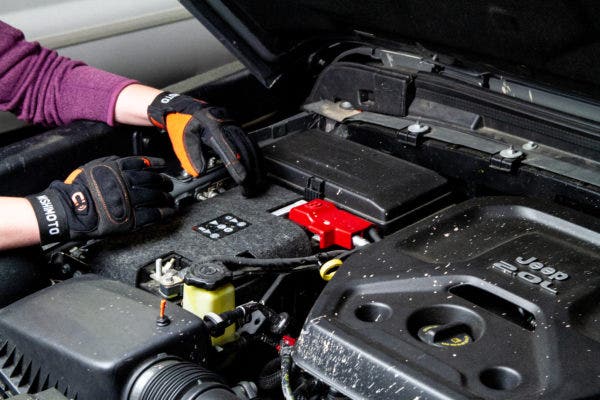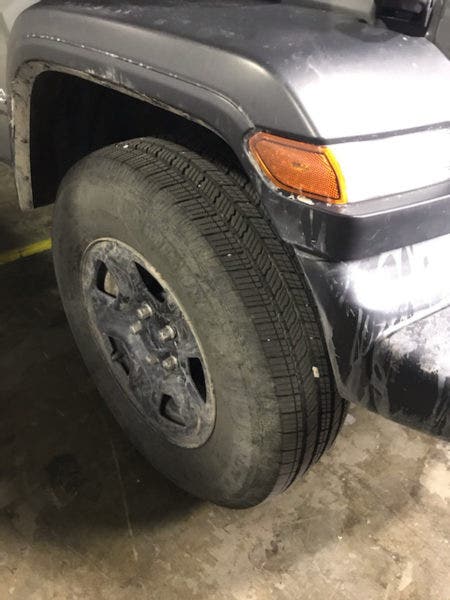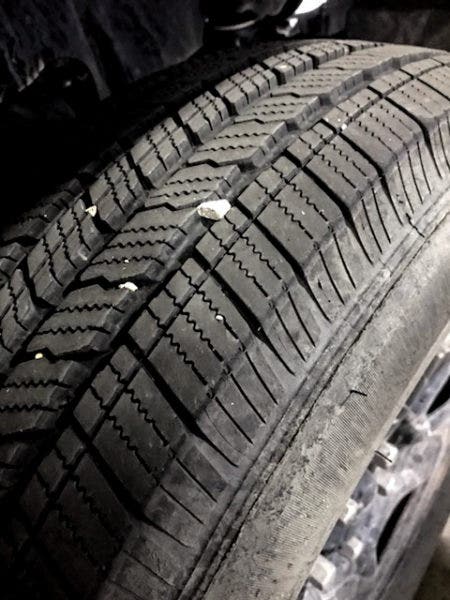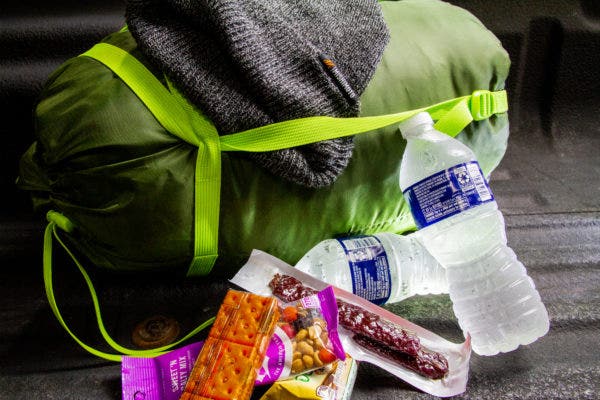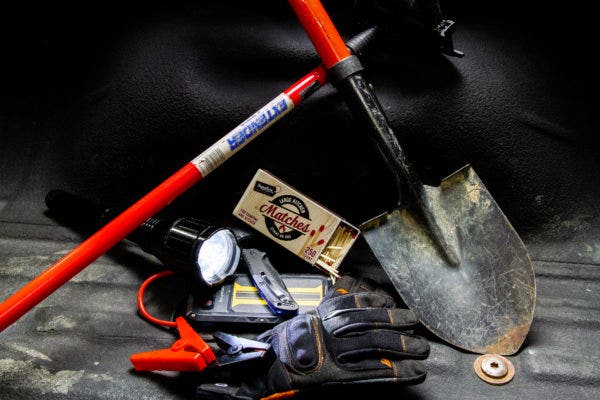
10 Ways To Start Winterizing Your Jeep
Proper vehicle preparation and maintenance can ensure your Jeep survives the low temperatures of winter. We put together a list of 10 checklist items you can complete to give yourself peace of mind as the temperatures drop. We recommend starting this list around October if you're in the Northern Hemisphere and May if you're south of the equator. Follow this checklist to make sure you're ready for the season ahead.
1. Test Your Battery
If possible, have your battery tested prior to the cold weather snap and replace if it's testing weak. This preventive maintenance could save you from missing a day at work or being stranded off-roading after a no-start.
So why does this happen in winter? When the terminals on a battery are connected, a chemical reaction generates electrons to supply power. Lowering the temperature of the battery slows the chemical reaction, which results in less current output. This is why battery failures commonly occur just as the ambient temperature begins to drop. At freezing temperature, battery capacity can be reduced by up to 20%! Your battery system also experiences more load in the winter because the oil in your engine thickens as the temperature drops resulting in your engine producing more resistance to cranking.
The most accurate way to test your battery is with a Battery Load Tester, but you don't necessarily need to shell out for one of these, most auto shops offer free battery testing.

2. Check your Belts, Boots, and Hoses
It is a good idea in general to regularly check your engine components and doing so specifically before winter eliminates emergency repairs. Wear and tear on your rubber engine components can easily turn into waiting for road-side assistance or even worse, being stranded in the bitter cold in a remote location. When rubber gets cold, it becomes brittle, and can easily crack so we recommend taking a look at your belts, boots and hoses.
Take a look at your belt(s) with the vehicle turned off to check the rubber for any cracking, especially at areas where the belt turns over a pulley. Also pay close attention to the edges of the belt for any torn strands. If you see any evidence of this wear, it is highly recommended that you replace the belt. Belt replacement is normally a quick process, so you don't need to set aside a full weekend for the job.
Check all lines for cracking and check to see if the texture of the material is soft and flexible. The hose or boot should be slightly spongy and should return to its original shape after being squeezed. Check all connections for seeping or leaking, and address these with new clamps, hoses, or boots, as necessary. Some modern systems use plastic quick disconnects that utilize O-rings for sealing. If a connection is leaking, replace the O-ring or the entire part if needed. If you have any doubts about a line, hose, or boot, it would be wise to replace that component before it becomes a problem down the road.
You can always take this opportunity to upgrade to silicone hoses. We have a variety of direct-fit hoses for Jeeps in attractive colors. Our hoses are made of 5 layers of silicone with embedded heat-resistant fibers for improved durability and heat and pressure tolerance. They also look fantastic if I do say so myself. As with all Mishimoto products, our silicone coolant hose kits also include our signature Lifetime Warranty and Accident Protection.

3. Test and/or Change your Coolant
If you do decide to upgrade your hoses, now's a great time to check this off your list too. When coolant freezes, serious damage can happen to your engine. Your engine is designed with numerous press-fit plugs (freeze plugs) that are made to rupture if the internal fluid freezes. If a plug ruptures, you will be treated to a leaking coolant system. If a plug does not function, freezing water will cause damage to the engine block and cylinder liners, and the remedy for that is an engine replacement.
Make sure to check your cooling system to ensure that it has the correct mixture of antifreeze and water for your vehicle and if the coolant has not been changed in years, it's a good time to flush it because it can be heavily saturated with sediment and particulates, reducing its cooling efficiency. Vehicles require a 50/50 mix of water and antifreeze for proper cooling, protection of internal passages and components, and protection against fluid freezing. You can use a coolant tester to determine the ratio of your current coolant or you can replace your coolant depending on the winter predicted. While you are testing your coolant for proper mixture ratio, take this opportunity to inspect the core and end tanks of the radiator for any leaks.

4. Add a Coolant Filtration Kit
Our Filtration Kit is a must for your Jeep year-round, and the potential issues you might encounter during winter makes this even more crucial to install. You know the importance of clean coolant for the efficiency of your cooling system, so make sure to keep that recently changed coolant and peak operating level.
Coolant is an obvious need to keep your Jeep going, but what we've found for the 2012-2018 JK is that casting sand from manufacturing is circulating through your coolant system wreaking havoc. This is a known issue that many Jeep owners have tried to claim under their warranty to no avail. That's why we developed our filtration kit to capture the grit for easy disposal. When we first tested this kit, our team captured considerable amounts of sand after 800 miles of testing. We can all agree this is not something you want in your system at any time. Consider adding this coolant filtration kit before temperatures drop to avoid any issues that could lead you stranded in the cold.

5. Wash the Salt Away
During the winter season, we recommend getting regular undercarriage washes. When big snowstorms are on their way, roads are lined with salt that is great for preventing roads from re-freezing, but terrible for the long-term life of your Jeep. Salt speeds up the corrosion process and can affect exposed metal surfaces. Try to get an undercarriage wash after each major snowstorm
6. Check Your Tires
We know as a Jeep owner you love your tires, so make sure they love you back this season. Tires have an impact on grip, ride quality, braking, and of course safety so it's a good time to check yours while making these inspections. First, you will want to confirm that your tires are rated for use in the snow. While your off-road tires look rugged enough to take on any terrain, they may only be designed for mud and dirt use. You can check for an “M+S” or a Mountain/Snow symbol on the sidewall of your tire to make sure you can drive safely in the snow.
Next, perform a basic inspection of the integrity of your tires, starting with the tread. Make sure that your tread is not worn past safety regulations. If they're bald, it's a no-brainer that you should replace your tires, but if they are right on the cusp of being too worn, consider replacing them instead of risking the season.
While you're looking at tread also look for any debris lodged in the rubber itself that could cause a leak. You may be able to patch these holes yourself. Once you have determined your treads are in good enough condition to last the winter, inspect the sidewalls of your tires for any cuts, bubbles, gashes, or damage. The sidewall is normally not repairable, so if there is a nail or anything penetrating this portion, the tire will need to be replaced. Additionally, a bubble in the sidewall indicates a failure of the internal liner and each of these failures create a tire that is more prone to a blowout or air leaks.

7. Look At Your Windshield
Before winter hits you'll want to make sure your view isn't obstructed with cracks that compromise the integrity of your windshield. Your windshield is an easy item to check with the obvious check to see if you have a huge crack running across your view. If not – that's great! Where it gets tougher is checking for tiny cracks and chips that could lead to that big crack. These tiny nicks are tougher to see, but they only need a quick change in temperature to spread. We're sure you can imagine a cold winter day where you blast your defrosters on high; this is exactly when that crack will spread and ruin your day.
To find the tiny cracks, you'll need to clear your windshield of dirt and debris and look closely. Sorry, no fancy tricks here! If you do find a small crack, this damage can be easily repaired with an at-home kit and is usually covered by insurance if you want professionals to handle the task. Anything larger than a dollar bill is going to cost you a whole new piece of glass so it's best to spot these early on. While you're looking at your windshield, check your wiper blades to see that they're in good condition. Rough looking blades don't clean snow slush that well… The replacement cost will range from $12-$30 so it's an inexpensive switch. Also, something to consider, any time you find cracks in your windshield it's recommended to switch your blades in case fragments are stuck in the rubber.

8. Check your heating system
Your heater is the most important part of your Jeep in the winter because whether you have a soft top or hard top, your Jeep is not as insulated as other vehicles on the road. It can get very cold in your cabin, so Jeep heating systems are built to do double duty for you. Jeeps are equipped with an HVAC heating system to quickly heat up your cabin to melt snow and keep passengers warm. With your top down all summer and warm temperatures continuing into September, you may not have had a need to flip your heat on. Make sure to check that your heater is in working condition before the cold arrives. If your Jeep blows out cold air, you know you need to make a fix, but if it blows out lukewarm when the heat is on full strength, this could be due to a clogged heater core. If this is the case for you, make sure to take a closer look at our coolant filtration kit post.

9. The Hard Top/Soft Top Decision
This isn't mandatory, but you can make the switch to your hard top before winter hits. Hard tops not only keep your Jeep better insulated from the cold, they also protect your Jeep from heavy snow accumulation and ice.
If you decided to keep your soft top through winter, you will need to perform more maintenance throughout the season. Before it gets cold, make sure to complete a thorough check for damage to zippers or the fabric of your top that could let cold air and precipitation into your cabin, causing ice to form on internal parts. If you find damage, now is the time to get this repaired.
During winter, you will need to make sure to scrape off any snow and break ice from your roof to maintain the integrity of your top. A great way to clear your roof is by using your powerful heater to melt snow and ice. You can also use the brush side of a scraper to push snow off. Never use the sharp side of your scraper on your soft top unless you like scratches on your vinyl windows and possible tears in your top's fabric.
*With frigid temperatures, please do not attempt to unzip windows or remove your top (unless replacing it with a hard top). The low temperatures make your top brittle and you'll risk damaging it or in some unfortunate cases, you won't be able to put your top back up with the decrease in fabric flex.
10. First Aid and Emergency Kit
While this list will help limit the failures you could experience during winter, it will not eliminate all possibilities, so we recommend outfitting your Jeep with some emergency supplies. This is especially important if you are traveling through extreme terrain or remote areas. Below is a list of items you should consider stocking for emergency situations. You can get pre-made kits that contain a majority of these necessities, or you can piece it together with what you own currently and make additions when needed.
- Small shovel
- Windshield scraper and small broom
- Flashlight with extra batteries
- Several water bottles
- Snack food (energy bars, raisins, nuts, candy bars)
- Waterproof matches and small candles
- Extra hats, socks, and gloves
- First-aid kit
- Winch-rope/pulley
- Small knife
- Any medications you normally take (small portion)
- Blankets or sleeping bag
- Tow chain or rope
- Small bag of cat litter (for wheel traction in case you become stuck)
- Jumper cables or portable jumpstarter
- Emergency flares
If you completed all these checks and tasks, you should be ready to hit the road (or off-road) this winter. You can check out our full line of performance parts at Mishimoto.com and continue reading more of our engineering adventures at Mishimoto.com/engineering.
Thanks for reading this post!




